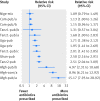Impact of introduction of rapid diagnostic tests for malaria on antibiotic prescribing: analysis of observational and randomised studies in public and private healthcare settings
- PMID: 28356302
- PMCID: PMC5370398
- DOI: 10.1136/bmj.j1054
Impact of introduction of rapid diagnostic tests for malaria on antibiotic prescribing: analysis of observational and randomised studies in public and private healthcare settings
Erratum in
-
Impact of introduction of rapid diagnostic tests for malaria on antibiotic prescribing: analysis of observational and randomised studies in public and private healthcare settings.BMJ. 2017 Jun 29;357:j3168. doi: 10.1136/bmj.j3168. BMJ. 2017. PMID: 28663173 Free PMC article. No abstract available.
Abstract
Objectives To examine the impact of use of rapid diagnostic tests for malaria on prescribing of antimicrobials, specifically antibiotics, for acute febrile illness in Africa and Asia.Design Analysisof nine preselected linked and codesigned observational and randomised studies (eight cluster or individually randomised trials and one observational study).Setting Public and private healthcare settings, 2007-13, in Afghanistan, Cameroon, Ghana, Nigeria, Tanzania, and Uganda.Participants 522 480 children and adults with acute febrile illness.Interventions Rapid diagnostic tests for malaria.Main outcome measures Proportions of patients for whom an antibiotic was prescribed in trial groups who had undergone rapid diagnostic testing compared with controls and in patients with negative test results compared with patients with positive results. A secondary aim compared classes of antibiotics prescribed in different settings.Results Antibiotics were prescribed to 127 052/238 797 (53%) patients in control groups and 167 714/283 683 (59%) patients in intervention groups. Antibiotics were prescribed to 40% (35 505/89 719) of patients with a positive test result for malaria and to 69% (39 400/57 080) of those with a negative result. All but one study showed a trend toward more antibiotic prescribing in groups who underwent rapid diagnostic tests. Random effects meta-analysis of the trials showed that the overall risk of antibiotic prescription was 21% higher (95% confidence interval 7% to 36%) in intervention settings. In most intervention settings, patients with negative test results received more antibiotic prescriptions than patients with positive results for all the most commonly used classes: penicillins, trimethoprim-sulfamethoxazole (one exception), tetracyclines, and metronidazole.Conclusions Introduction of rapid diagnostic tests for malaria to reduce unnecessary use of antimalarials-a beneficial public health outcome-could drive up untargeted use of antibiotics. That 69% of patients were prescribed antibiotics when test results were negative probably represents overprescription.This included antibiotics from several classes, including those like metronidazole that are seldom appropriate for febrile illness, across varied clinical, health system, and epidemiological settings. It is often assumed that better disease specific diagnostics will reduce antimicrobial overuse, but they might simply shift it from one antimicrobial class to another. Current global implementation of malaria testing might increase untargeted antibiotic use and must be examined.
Published by the BMJ Publishing Group Limited. For permission to use (where not already granted under a licence) please go to http://group.bmj.com/group/rights-licensing/permissions.
Conflict of interest statement
Competing interests: All authors have completed the ICMJE uniform disclosure form at
Figures



Comment in
-
Do rapid diagnostic tests improve overall quality of care?BMJ. 2017 May 11;357:j2290. doi: 10.1136/bmj.j2290. BMJ. 2017. PMID: 28495670 No abstract available.
References
-
- Carattoli A. Plasmids and the spread of resistance. Int J Med Microbiol 2013;303:298-304. 10.1016/j.ijmm.2013.02.001. pmid:23499304. - DOI - PubMed
-
- Manenzhe RI, Zar HJ, Nicol MP, Kaba M. The spread of carbapenemase-producing bacteria in Africa: a systematic review. J Antimicrob Chemother 2015;70:23-40. 10.1093/jac/dku356. pmid:25261423. - DOI - PMC - PubMed
-
- Mathers AJ, Peirano G, Pitout JD. The role of epidemic resistance plasmids and international high-risk clones in the spread of multidrug-resistant Enterobacteriaceae. Clin Microbiol Rev 2015;28:565-91. 10.1128/CMR.00116-14 pmid:25926236. - DOI - PMC - PubMed
-
- Oneko M, Kariuki S, Muturi-Kioi V, et al. Emergence of Community-Acquired, Multidrug-Resistant Invasive Nontyphoidal Salmonella Disease in Rural Western Kenya, 2009-2013. Clin Infect Dis 2015;61(Suppl 4):S310-6. 10.1093/cid/civ674. pmid:26449946. - DOI - PubMed
-
- Baker KS, Dallman TJ, Ashton PM, et al. Intercontinental dissemination of azithromycin-resistant shigellosis through sexual transmission: a cross-sectional study. Lancet Infect Dis 2015;15:913-21. 10.1016/S1473-3099(15)00002-X. pmid:25936611. - DOI - PubMed
MeSH terms
Substances
Grants and funding
LinkOut - more resources
Full Text Sources
Other Literature Sources
Medical
